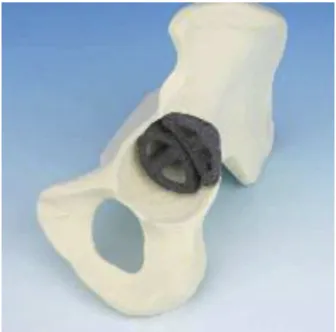w w w . r b o . o r g . b r
Original
Article
Evaluation
of
the
fixation
of
the
trabecular
metal
wedge
in
patients
undergoing
revision
of
total
hip
arthroplasty
夽
,
夽夽
Victor
Magalhães
Callado
∗,
Osamu
de
Sandes
Kimura,
Diogo
de
Carvalho
Leal,
Pedro
Guilme
Teixeira
de
Sousa
Filho,
Marco
Bernardo
Cury
Fernandes,
Emílio
Henrique
Carvalho
de
Almendra
Freitas
InstitutoNacionaldeTraumatologiaeOrtopedia(Into),RiodeJaneiro,RJ,Brazil
a
r
t
i
c
l
e
i
n
f
o
Articlehistory: Received22July2013 Accepted30July2013 Availableonline3May2014
Keywords: Hiparthroplasty
Trabecularmetalaugment Prosthesesandimplants Acetabularbonedefects
a
b
s
t
r
a
c
t
Objective:thisstudyaimedtoevaluatethefixationofthetrabecularmetalwedgeinpatients undergoingrevisionoftotalhiparthroplasty.
Methods:twenty-threecaseswithminimumgradingofPaproskyII-Bthatwereoperated betweenJuly2008andFebruary2013wereevaluated.Thesecaseswereevaluatedbasedon radiographsbeforetheoperation,immediatelyaftertheoperationandlateronafterthe operation.Lossoffixationwasdefinedasachangeintheabductionangleofthecomponent greaterthan10◦oranymobilizationgreaterthan6mm.
Results:itwasfoundthattherewas100%fixationoftheacetabulaafterameanof29.5 months.Onecaseunderwentremovaloftheimplantedcomponentsduetoinfection. Conclusions:thereisstillnoconsensusregardingthebestoptionforreconstructinghipswith boneloss.However,revisionusingatrabecularmetalwedgehaspresentedexcellent short-andmedium-termresults.Thisqualifiesitasanimportanttoolforachievingafixedand stableacetabularcomponent.
©2014SociedadeBrasileiradeOrtopediaeTraumatologia.PublishedbyElsevierEditora Ltda.Allrightsreserved.
Avaliac¸ão
da
fixac¸ão
da
cunha
de
metal
trabeculado
em
pacientes
submetidos
à
revisão
de
artroplastia
total
de
quadril
Palavras-chave: Artroplastiadequadril Cunhademetaltrabeculado Próteseseimplantes Defeitosósseosacetabulares
r
e
s
u
m
o
Objetivo:avaliarafixac¸ãodascunhasdemetraltrabeculado(CMT)empacientessubmetidos àrevisãodeartroplastiatotaldequadril.
Métodos:foramavaliados23casosgraduadosnomínimocomoII-BdePaprosky,operados entrejulhode2008efevereirode2013.Oscasosforamavaliadoscombasenasradiografias préepós-operatóriasimediatasetardias.Aperdadafixac¸ãofoidefinidacomoumavariac¸ão
夽Pleasecitethisarticleas:CalladoVM,deSandesKimuraO,deCarvalhoLealD,TeixeiradeSousaFilhoPG,CuryFernandesMB,Carvalho deAlmendraFreitasEH.Avaliac¸ãodafixac¸ãodacunhademetaltrabeculadoempacientessubmetidosàrevisãodeartroplastiatotalde quadril.RevBrasOrtop.2014;49:364–369.
夽夽
WorkperformedintheDepartmentofOrthopedicsandTraumatology,InstitutoNacionaldeTraumatologiaeOrtopedia(INTO),Riode Janeiro,RJ,Brazil.
∗ Correspondingauthor.
E-mail:victorcallado@uol.com.br(V.M.Callado).
2255-4971/$–seefrontmatter©2014SociedadeBrasileiradeOrtopediaeTraumatologia.PublishedbyElsevierEditoraLtda.Allrightsreserved.
doângulodeabduc¸ãodocomponentemaiordoque10◦ouqualquermobilizac¸ãomaiordo que6mm.
Resultados: verificou-se100%defixac¸ãodosacetábulosapós29,5mesesemmédia.Umcaso foisubmetidoàretiradadoscomponentesimplantadosporinfecc¸ão.
Conclusões: aindanãoháconsensonoquedizrespeitoàmelhoropc¸ãodereconstruc¸ãodo quadrilcomperdaóssea,porémarevisãocomCMTvemapresentandoexcelentesresultados emcurtoemédioprazo.Talfatoaqualificacomoumaimportanteferramentanaobtenc¸ão deumcomponenteacetabularfixoeestável.
©2014SociedadeBrasileiradeOrtopediaeTraumatologia.PublicadoporElsevier EditoraLtda.Todososdireitosreservados.
Introduction
Yearbyyear,thetotalnumberofhiparthroplastyprocedures in Brazil and worldwideis growing. This is related to the goodclinicalresultsobtainedthroughthisprocedure,which involvespainrelief andasubstantial improvementinjoint function.1
Withimprovementsinthetechniques,materialsand pros-theses,theresultsobtainedhavebecomeeverbetter,bothin qualityand inlongevity. However,somepatients willneed toundergo revisionsurgeryduetoasepticloosening, insta-bility, infection or osteolysis.2 Osteolysis is responsible for
originatingacetabulardefectsthatmakeitdifficulttoachieve prosthesisstabilityduringrevisionsurgery.Thisisthemain challengeinthissurgery.
Classificationofacetabulardefectsisanimportantstepin preoperativeandintraoperativeplanning.Paproskyetal.3
pro-posedthreemaingroupsbasedonosteolysisoftheischium (posteriorspine)andtheteardrop(medialwall)andthedegree ofupwardmigrationoftheacetabulum(acetabularceiling).
Several reconstructionstrategieshave been putforward fortreatingacetabulardefects: animplant tokeepthe cen-terofrotationabovetheanatomicalposition4;a“jumbocup”
component(prostheseslargerthan65mmforbothgendersor largerthan66mmformenand62mmforwomen)5;anoblong
prosthesis;ahemisphericalprosthesisinassociationwitha homologousstructuralorcrushedgraft;anti-protrusionrings; anda prosthesisusedinassociationwith trabecularmetal wedges(Fig.1).4–7
Placement of the prosthesis above the original center of rotation may cause alterations to gait biomechanics.8
Homologousstructuralgrafts present the potentialfor dis-ease transmission, require tissue bank infrastructure and presentpreparationdifficultyandthepossibilityof reabsorp-tion.Oblongcomponentsdonotalwaysadapttothedefect. Useofascreeninassociationwithadicedgraftisanoption foryoungpatients forwhom it isdesirabletoimprove the bonestock,butthismethodpresentsthesameproblemsas mentionedaboveinrelationtostructuralgrafts.9
Thetraditionalporous implants madeof titanium have becomewellestablishedinlong-termstudiesonacetabular revisions,butasignificant increaseinthefailure rateafter thefirstdecadeinvivohasbeenobserved.10Inthiscontext,
thesearchforlong-lastingbiologicalfixationhasstimulated theuseoftrabecularmetalimplants.Theseimplants,which aremadeofthemetaltantaluminacarbonskeletonof uni-formporosity,i.e.astructurewithphysicalandmechanical
propertiessimilartothoseofbone,arecharacterizedbyhigh porosity ofaround 75–80%by volume,in comparisonwith 30–50%forporoustitaniumimplants.Thisarchitecture pro-videsdifferencesinthebiomechanicalprofileofthematerial, andoffersalargerareaforgrowthofnativebone.This there-forecontributestowardincreasingtheresistancetoshearing attheprosthesis-boneinterface(highcoefficientoffriction). Theseimplantshaveacoefficientofelasticityclosetothatof boneandlowerthanthatoftraditionalimplants.Thegreater stabilityhasbeenattributedtotherelativeelasticityandthe highcoefficientoffriction.11Studiesonhistologicalsections
fromthemetal-boneinterfacehavealsofoundthatthereis ahigherrateofinvasivebonegrowthintheporesofthe tra-becular metalthan intraditionalporousimplants (Fig.2).12
Inadditiontothemechanicaladvantage,theseimplantsalso presentthepossibilityofadaptationoftheirsizetothebone defectsthatarefound,anddonotpresentanyriskof reab-sorption.
Objective
Theaimofthisstudywastoassessthefixationoftrabecular metalwedgesinpatientswhounderwentasepticrevisionof totalhiparthroplasty.
Fig.2–Electronicphotomicrographshowingthehighly porousstructuremadeoftantalum(www.zimmer.com).
Material
and
methods
Thesamplewasformedbypatientswhounderwenthip revi-sionarthroplastyduetoasepticfailure,betweenJuly2008and February 2013. During this period, 425hip revision arthro-plastyprocedureswereperformedusingtrabecularmetalfor theacetabularcomponent. Ofthese, 23patientsreceived a trabecularmetalwedge.
Trabecularmetalwedgesareavailableindifferentshapes andsizes.Theycanbedividedintothreemajorgroups: con-ventionalsemicirculartype;spinalorseven-shapesupports; andchock-shapetype.13Inourstudy,weonlyused
conven-tionalsemicircularwedges(Fig.3A–C).
Thepatients’meanagewas58years(range:39–81years); 12weremale(52.2%)and11werefemale(47.8%).Themodified Kocher-Langenbeckposterolateralaccesswasusedinallthe procedures.
Weusedthefollowingparametersforindicatingtheuse ofatrabecularmetalwedge,intraoperatively:lackofcoverage oftheacetabularcomponentgreaterthan40%14orsituations
inwhichstablefixationoftheacetabularcomponentwasnot achievedwithoutplacementofawedge.
The evaluation consisted of analyzing anteroposterior radiographsofthepelvisandlateralradiographsofthe oper-atedhip. Thedegree of osseointegration of the acetabular domewasascertainedusingtheclassificationofMooreetal.15
Five radiographic parameters were used: absence of radi-olucency lines; presence of superolateral support; medial stress-shielding;radialtrabeculaeandinferomedialsupport.
Fig.3–Typesofwedgeavailable.15(A)Semicircular;(B)
spinalorseven-shapedsupport;(C)chock-shaped.
Presence of three or more signs had a positive predictive valueof96.9%,sensitivityof89.9%and specificityof76.9% forosseointegration.Theseparameterscouldnotbe extrap-olated to osseointegration of the wedge, as described by Abolghasemianetal.13
Lossoffixationofthetrabecularmetalwedgewasdefined radiologicallyasachangeintheabductionangleofthe compo-nentthatwasgreaterthan10◦,oranymobilizationinavertical
Table1–CasedistributioninaccordancewithPaprosky etal.3
I II-A II-B II-C III-A III-B
No.ofcases – – 5 1 10 7
% – – 21.7 4.3 43.5 30.5
Wecomparedthepositionofthecenterofhiprotationfrom beforetoaftertheoperationandmeasuredthisinrelationto thecontralateralhip.
The postoperative rehabilitation consisted of partial weight-bearingwiththeaid ofcrutches foreighttotwelve weeks. Consultations were provided after two weeks, one month,threemonths,sixmonthsandyearlythereafter.Allthe patientsreceiveddrugprophylaxisfordeepveinthrombosis usinglowmolecularweightheparinfor30days.
Statistical analysis was performed using the Microsoft OfficeExcel2010software.Thedatawereanalyzedusing Stu-dent’sttestandfindingswithap-value<0.05weretakento besignificant.Kaplan–Meiersurvivalanalysiswasperformed with a95% confidence interval in order to investigate the survivalofthe implant,usingthe cutoffpoint ofthe need for another revision and failure according to radiographic criteria.
Results
The acetabular defects were classified in accordance with Paproskyetal.,3asindicatedinTable1.
Themeansizeoftheacetabulardomeswas56mm(range: 48–68mm).Thetotalnumberoftrabecularmetalwedgesused was23(allofthemoftheconventionaltype),rangingin thick-nessfrom 10to30mm andindiameterfrom 48to62mm. Noneofthepatientsneededmorethanonewedge.Themean numberofscrewsusedineachwedgewas1.7(range:1–2).All theinsertsusedweremadeofpolyethyleneandno constrict-inglinerswereused.Thenumberoflinersuseddependedon thediameterofthehead:thus,fivelinerswereusedforhead 28and18forhead32.
Theradiographicanalysisdidnotshowanysignsofaseptic looseninginanyofthecases.Therewasonecaseofinfection, but without clinicalor radiographic signs ofseptic loosen-ing.Culturingperformedduringtheoperationwasnegative andthe ultrasensitiveC-reactiveprotein(CRP) valuebefore theoperationwas0.6(normal<5.0).Threemonthsafterthe operation,thiscasepresentedclinicalandlaboratorysignsof infection,andtheimplantwasremoved.Atthetimeof remov-ingtheimplants,thewedgewasseentobefixed.Currently, thispatientstilldoesnothaveahipprosthesis,butalsodoes nothaveanysignsofactiveinfection.
Themeannumberofsurgicalproceduresperformedbefore placementofthewedgeswas1.5(range:1–4).Thetimethat had elapsed from the last surgery until placement of the wedgewas15.5years(range:1–31).Themean preoperative CRPvaluewas3.64(range:0.32–5.0).
ThesurvivalratefoundusingKaplan–Meiersurvival anal-ysiswas90.9%after28months.Thecomponentfixationrate was100%afterameanfollow-upof29.5months,sincenone ofthe casespresentedany clinicalorradiographicsigns of
loosening.Alltheacetabulardomespresentedthreeormore signs offixation, in accordance with the criteria ofMoore etal.15
We used the score of D’Aubigné and Postel16 to make
clinicalcomparisonsbetweentheresults.Themean preop-erativescorewas6.65points(range:4–10)andthisincreased aftertheoperationto15.96points(range:13–18).This differ-encewasstatisticallysignificant,accordingtoStudent’sttest (p<0.0001).
Thecapacityforrestorationofthenormalcenterof rota-tionintherevisedhipwasmeasured.Fivehipswereremoved fromthisanalysisofthedatabecausethecontralateralhiphad previouslyundergonearthroplasty.Beforetheoperation,the centerofrotationwasfoundtobehigh(>35mm)in10ofthe18 hips(55.5%),withameandistanceof32mm(range:5–56mm) abovethe centerofrotationofthe contralateralside.After theoperation,themeandecreasedto14mm(range:0–31mm), whichwasastatisticallysignificantdifference(p=0.0001),and noneofthehipscontinuedtopresentahighcenterofrotation. Therewasameanimprovementinthelocationofthecenter ofrotationof17mm(range:0–54mm).
Discussion
Revision of the acetabular component is a complex and laborious stageinhip arthroplasty revision.Several factors contributetowardthisdifficulty,suchasbonedefects,which areoftenunderestimatedbeforetheoperation,andthe mod-ifiedsurgicalanatomyofthehip.17
TypeIandIIdefectspresentgoodlong-termresultswhen treatedusingnon-structuralgrafts.18Ontheotherhand,type
IIIlesions,whicharecharacterizedbysignificantboneloss, require reconstructionthatwillprovide greaterstabilityfor theimplant.For this,structuralgrafts,reinforcementrings, oblongprosthesesortrabecularmetalwedgescanbeused.19
Reconstruction using a structural graft together with a cemented acetabular component has shown poor clinical results.20 Anti-protrusion rings present high complication
ratesbecauseofthecomplexityofthereconstruction, biome-chanicalstabilityandmaterialused.9WeedenandSchmidt21
reported that they obtained satisfactory results in smaller defects,butthatasthedefectsbecamemoresevere,the tradi-tionalimplantstendedtofail.FortypeIIIAdefects,DelGaizo etal.22recommendedthatallogeneicstructuralgraftsshould
onlybeusedforveryyoungpatients,whowouldrequirenew revisionsinordertoimprovethebonestock.
Trabecularmetalwedgeshavebeenpresenting encourag-ingresults,accordingtothelatestpublisheddata.In23hips with type 111A and IIIBdefects, Lingaraj et al.23 observed
that95.6%ofthe implantsremainedfixedafter41months. In43patientswithtype111AandIIIBdefects,Weeden and Schmidt21founda98%successrateoveraperiodof2.8years.
In23hipsfollowedupfor35months,Flecheretal.24didnot
observeanylossoffixationoftheacetabularcomponents.In 37casesoftypeIIIAdefects,DelGaizoetal.22reportedsurvival
of97.3%overa60-monthperiod.Borlandetal.25 reporteda
thattwocasesrequiredrevisionduetolooseningor migra-tion.In34patientswithdefectsrangingfromtypeIIAtotype IIIBwho werefollowedup for24months,Siegmeth etal.27
reportedsurvivalof94.11%.SporerandPaprosky28published
aseriesof28patientswithtypeIIIAdefectsandfollow-upof 37months,whopresentedsurvivalof96.5%.
AnincreaseinthescoreofD’AubignéandPostel16hasalso
beenreportedbyotherauthors.Among24casesinwhich tra-becularmetalwedgeswereusedinassociationwithcemented acetabula, which were followed up for five years, Borland etal.25reportedthattherewereimprovementsintheWOMAC
andSF-36functionalscores(p<0.005).In37patients,DelGaizo etal.22reportedthattherewasanimprovementintheHarris
HipScorefrom33.0to81.5points.Among38patientswith typeIIIAandIIIBdefectswhowerefollowedupfor25months, Hasartetal.26 observedthattheMerled’Aubignéfunctional
scoreincreasedfrom6to13pointsandtheHarrisHipScore from29to79points.
Weshowedaverticalimprovementinthecenterof rota-tionfrom32mmto14.6mm.Beforetheoperation,72.2%of the hipspresenteda center withadifference greater than 20mm,whilethiswasseeninonly33.3%aftertheoperation. Biomechanicalstudies8haveshownthatanupward
displace-mentofthecenterofrotationbynotmorethan20mmdid notaffectthegaitorabductormusculature.Abolghasemian etal.13reportedthattherewasanimprovementinthe
loca-tionofthecenterofrotationin79.4%ofthehips.Theirmean correctionwas9.9mm.Inourstudy,themeancorrectionwas 17mm.Hasartetal.26 reportedthattherewasan
improve-mentinthecenterofrotationofthehipfrom35mm(range: 16–55mm)to14mm(range:5–27).Siegmethetal.27reported
that there was an improvement in the center of rotation from50mmto28mm.Onlythreeoftheir33patients contin-uedtopresentahighcenterofrotationaftertheoperation, whereas 30 had shown this beforethe revision surgery.In oursample,noneofourpatientspersistedwithahighhip center.
Thecomplication rate in ourstudy was 4.1%(one case ofinfection).Del Gaizoetal.22reportedacomplicationrate
of21.6%,whichwasinlinewithotherlong-termstudieson outcomes fromcomplex revisionsoftotalhip arthroplasty. Among97revisionsurgeryprocedures,VanKleunenetal.17
reportedaninfectionrateof8.2%.
Trabecularmetalwedgeshave theadvantageofbeing a modular systemthat is technically simpler, quickly imple-mented andwithout any potentialforreabsorption. Italso avoids the morbidity caused by graft removal for recon-struction.Themicroporosityofthematerialfavorsbiological fixationoftheimplantandfeedstheexpectationofachieving long-lastingstability.29
Amongthedisadvantagesobserved,wecancitethe poten-tialfor generatingdebrisat thewedge/cement/acetabulum interface,highcost,incapacitytorestorethebonestockfor futurerevisionsandlackoflong-termdata.19
Conclusion
Trabecularmetalwedgeshavebeenshowntobeapromising optionformanagingsevereacetabulardefects.Theypresent
longsurvivalovertheshorttomediumterm,butlong-term follow-upisneededinordertobeabletodefinethetruerole ofthis technologyinrelation tothe traditionaloptionsfor reconstruction.
Conflicts
of
interest
Theauthorsdeclarenoconflictsofinterest.
r
e
f
e
r
e
n
c
e
s
1.VisuriT,KoskenvuoM,HonkanenR.Theinfluenceoftotalhip replacementonhippainandtheuseofanalgesics.Pain. 1985;23(1):19–26.
2.SullivanPM,MacKenzieJR,CallaghanJJ,JohnstonRC.Total hiparthroplastywithcementinpatientswhoarelessthan fiftyyearsold.Asixteentotwenty-two-yearfollow-upstudy.J BoneJointSurgAm.1994;76(6):863–9.
3.PaproskyW,PeronaP,LawrenceJ.Acetabulardefect classificationandsurgicalreconstructioninrevision arthroplasty.A6-yearfollow-upevaluation.JArthroplasty. 1994;9(1):33–44.
4.HarrisWH.Reconstructionatahighhipcenterinacetabular revisionsurgeryusingacementlessacetabularcomponent. Orthopedics.1998;21(9):991–2.
5.WhaleyAL,BerryDJ,HarmsenWS.Extra-largeuncemented hemisphericalacetabularcomponentsforrevisiontotalhip arthroplasty.JBoneJointSurgAm.2001;83(9):1352–7. 6.PatelJV,MasonisJL,BourneRB,RorabeckCH.Thefateof
cementlessjumbocupsinrevisionhiparthroplasty.J Arthroplasty.2003;18(2):129–33.
7.SporerSM,O’RourkeM,PaproskyWG.Managingbonelossin acetabularrevision.InstrCourseLect.2006;55:287–97. 8.DelpSL,WixsonRL,KomattuAV,KocmondJH.Howsuperior
placementofthejointcenterinhiparthroplastyaffectsthe abductormuscles.ClinOrthopRelatRes.1996;(328): 137–46.
9.GarbuzD,MorsiE,GrossAE.Revisionoftheacetabular componentofatotalhiparthroplastywithamassive structuralallograft:studywithaminimumfive-year followup.JBoneJointSurgAm.1996;78(5):693–7.
10.LewallenDG.Acetabularrevision:techniqueandresults.In: MorreyBF,editor.Jointreplacementarthroplasty.3rded Philadelphia:ChurchillLivingstone;2003.p.824.
11.MeneghiniMR.Mechanicalstabilityofnovelhighlyporous metalacetabularcomponentsinrevisiontotalhip arthroplasty.JArthroplasty.2010;25(3):337–41.
12.BobynJD,StackpoolGJ,HackingSA,TanzerM,KrygierJJ. Characteristicsofboneingrowthandinterfacemechanicsof anewporoustantalumbiomaterial.JBoneJointSurgBr. 1999;81(5):907–14.
13.AbolghasemianM,TangsatapornS,SternheimA,BacksteinD, SafirO,GrossAE.Combinedtrabecularmetalacetabularshell andaugmentforacetabularrevisionwithsubstantialbone loss:amid-termreview.BoneJointJ.2013;95-B(2):166–72. 14.JastyM.Jumbocupsandmorsalizedgraft.OrthopClinNorth
Am.1998;29(2):249–54.
15.MooreMS,McAuleyJP,YoungAM,EnghSrCA.Radiographic signsofosseointegrationinporous-coatedacetabular components.ClinOrthopRelatRes.2006;(444):176–83. 16.D’AubignéRM,PostelM.Functionalresultsofhip
17.VanKleunenJP,LeeGC,LementowskiPW,NelsonCL,Garino JP.Acetabularrevisionsusingtrabecularmetalcupsand augments.JArthroplasty.2009;24Suppl.6:64–8.
18.RondinelliPC,CabralFP,FreitasEH,PenedoJL,daSilveiraSLC, MedinaBT.Cirurgiaderevisãonaartroplastiaderevisãodo quadrilcomenxertodebancodeossos.RevBrasOrtop. 1993;28(6):343–52.
19.HarkessJW.Artroplastiadequadril.In:CanaleST,editor. CirurgiaortopédicadeCampbell.2003.p.315–471. 20.SporerSM,O’RourkeM,ChongP,PaproskyWG.Theuseof
structuraldistalfemoralallograftsforacetabular reconstruction:surgicaltechnique.JBoneJointSurgAm. 2006;88(Suppl1):92–9.
21.WeedenS,SchmidtR.Theuseoftrabecularmetalimplants forPaprosky3Aand3Bdefects.JArthroplasty.2007;226 (Suppl.2):151–5.
22.DelGaizoDJ,KancherlaV,SporerSM,PaproskyWG.Tantalum augmentsforIIIAacetabulardefects.ClinOrthopRelatRes. 2012;(470):395–401.
23.LingarajK,TeoYH,BergmanN.Themanagementofsevere acetabularbonedefectsinrevisionhiparthroplastyusing modularporousmetalcomponents.JBoneJointSurgBr. 2009;91(12):1555–60.
24.FlecherX,SporerS,PaproskyW.Managementofseverebone lossinacetabularrevisionusingatrabecularmetalshell.J Arthroplasty.2008;23(7):949–55.
25.BorlandWS,BhattacharyaR,HollandJP,BrewsterNT.Useof poroustrabecularmetalaugmentswithimpactionbone graftinginmanagementofacetabularboneloss.ActaOrthop. 2012;83(4):347–52.
26.HasartO,PerkaC,LehnigkR,TohtzS.Reconstructionoflarge acetabulardefectsusingtrabecularmetalaugments.Oper OrthopTraumatol.2010;22(3):268–77.
27.SiegmethA,DuncanCP,MasriBA,KimWY,GarbuzDS. Modulartantalumaugmentsforacetabulardefectsin revisionhiparthroplasty.ClinOrthopRelatRes.2009;467(1): 199–205.
28.SporerSM,PaproskyWG.Theuseofatrabecularmetal acetabularcomponentandtrabecularmetalaugmentfor severeacetabulardefects.JArthroplasty.2006;216(Suppl. 2):83–6.
29.NehmeA,LewallenDG,HanssenAD.Modularporousmetal augmentsfortreatmentofsevereacetabularbonelossduring revisionhiparthroplasty.ClinOrthopRelatRes.

